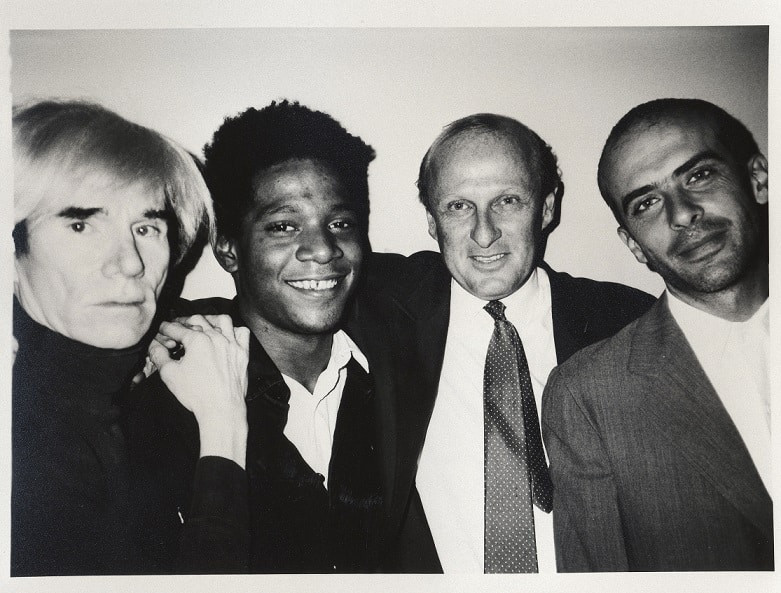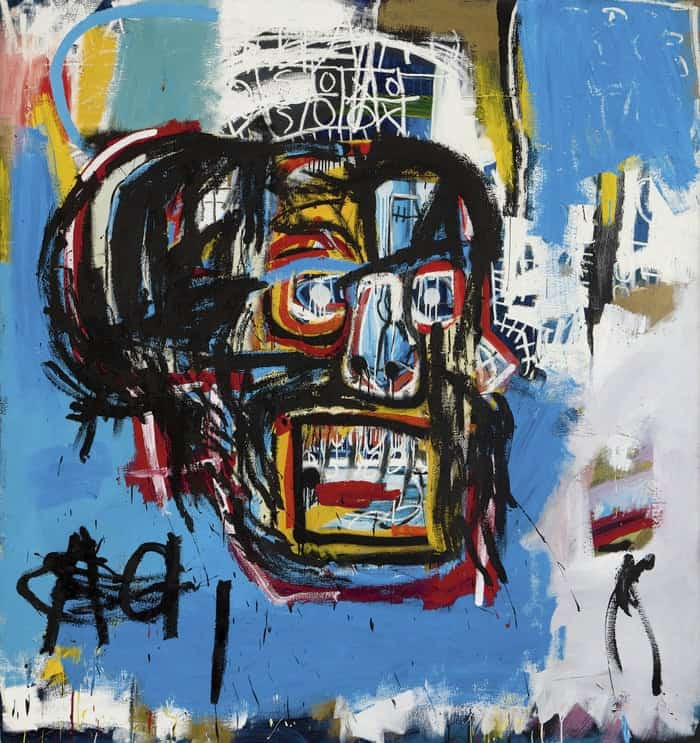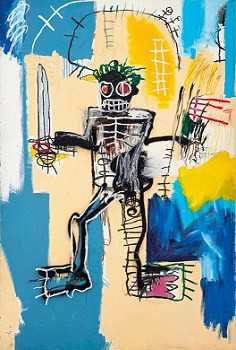Jean-Michel Basquiat, a name synonymous with both raw street art energy and profound contemporary art, remains an emblematic figure. Emerging from the gritty streets of 1980s New York, Basquiat was more than just a graffiti artist; he was a cultural phenomenon. His journey from tagging walls as SAMO to exhibiting in prestigious galleries is a testament to his relentless creativity and unwavering artistic vision. Basquiat’s art, characterized by its raw emotion and powerful social commentary, continues to resonate deeply with audiences worldwide, solidifying his place as a pivotal figure in art history and a key figure when discussing the evolution of the “Basquiat Street Artist” archetype.
The Formative Years of a Street Artist
Born in Brooklyn, New York in 1960, Jean-Michel Basquiat’s diverse heritage – Haitian and Puerto Rican – deeply influenced his artistic perspective. Growing up in Park Slope, he displayed early talents in writing, music, and drawing. His mother, herself an admirer of fashion design and sketching, nurtured his artistic inclinations, often drawing with him. Basquiat’s early inspirations ranged from cartoons and comics to the cinematic artistry of Alfred Hitchcock. Frequent visits to the Brooklyn Museum and the Museum of Modern Art with his mother exposed him to the wider world of art, planting seeds for his future endeavors as a groundbreaking artist.
SAMO©: The Birth of a Street Art Legend
Basquiat’s formal education took an unconventional turn when he enrolled in City-As-School, an experimental public school in Manhattan catering to gifted students. It was here that he encountered Al Diaz, a fellow young graffiti artist. Together, they conceived SAMO© (short for “same old shit”), a graffiti persona that became their rebellious voice across New York City. The streets became their canvas as they sprayed poetic and politically charged slogans on dilapidated buildings, subway cars, and urban walls. Lacking funds for traditional art supplies, Basquiat innovatively used walls, doors, and discarded furniture as surfaces for his burgeoning artistic expression. This period cemented his foundation as a true “basquiat street artist,” working outside conventional art spaces.
Dropping out of high school at seventeen, Basquiat fully embraced the artist’s life, leaving home and supporting himself by selling hand-drawn sweatshirts and postcards. He navigated the streets of Manhattan, sometimes living rough, sometimes finding shelter with friends. Canal Street, particularly Stan Peskett’s loft, became a hub for Basquiat, hosting gatherings that bridged the graffiti, music, and downtown club scenes. This vibrant underground culture significantly shaped his artistic development and worldview.
Transitioning from Street to Gallery: The Evolution of Basquiat
The SAMO© partnership with Diaz dissolved in 1980, marking a pivotal transition in Basquiat’s career. While SAMO© was never intended as mere graffiti, the label “graffiti artist” or “ex-graffiti artist” would follow Basquiat throughout his career. He viewed this term as reductive and racially charged, feeling it minimized the sophistication and depth of his work. He was evolving beyond the label of just a “basquiat street artist”.
That same year, a chance encounter with influential art critic and Metropolitan Museum curator Henry Geldzahler proved significant. Geldzahler reviewed The Times Square Show, a groundbreaking avant-garde exhibition curated by Colab and Fashion Moda, in which Basquiat participated alongside artists like Keith Haring. This exhibition became a watershed moment, signaling the art world’s burgeoning interest in Basquiat’s raw talent and the broader street art movement.
Fueled by this recognition, Basquiat participated in numerous group exhibitions, including New York/New Wave in 1981, which featured artists like Robert Mapplethorpe. This period also marked the beginning of a crucial friendship and mentorship with Andy Warhol, whom Basquiat met in the downtown club scene. Their subsequent collaborations would further propel Basquiat into the limelight and blur the lines between street art and high art.
 Jean-Michel Basquiat together with Andy Warhol, Bruno Bischofberger, and Fransesco Clemente
Jean-Michel Basquiat together with Andy Warhol, Bruno Bischofberger, and Fransesco Clemente
Andy Warhol, Jean-Michel Basquiat, Bruno Bischofberger, and Francesco Clemente photographed in New York (1984). Courtesy of Galerie Bruno Bischofberger, CC BY-SA 4.0
1982 marked Basquiat’s ascent to art world stardom. He secured his first solo exhibition in the United States at the Annina Nosei Gallery, showcasing iconic paintings like Arroz con Pollo, Self-Portrait, and Untitled (Two Heads on Gold). Nosei also provided him with studio space, further enabling his prolific output, and introduced his work to influential Los Angeles collectors. That year, Basquiat became the youngest artist to participate in documenta 7, exhibiting alongside established masters such as Anselm Kiefer, Cy Twombly, Gerhard Richter, and Joseph Beuys. This rapid rise confirmed his departure from the streets and his firm establishment within the contemporary art elite, yet his street art roots remained integral to his identity and artistic approach.
Jean-Michel Basquiat, Untitled, 1982 © Jean-Michel Basquiat. Fair Use.
The трагедия and Legacy of a Brilliant Artist
Basquiat’s career coincided with the Neo-expressionist movement, a resurgence of painting that saw the human figure return to prominence. He became a leading figure in this era, embodying its raw energy and emotional intensity. Despite his success, Basquiat grappled with prejudice stemming from his graffiti background and self-taught status. He yearned for acceptance within the art establishment but often felt like an outsider. The sudden death of Andy Warhol in 1987 deeply affected Basquiat. Warhol had been a confidante and a grounding influence, particularly regarding Basquiat’s struggles with drug use. In the aftermath, Basquiat became increasingly isolated, his depression and heroin addiction intensifying. Tragically, at the young age of 27, Jean-Michel Basquiat succumbed to a heroin overdose in his East Village apartment, leaving behind a legacy that continues to inspire and provoke.
Decoding Basquiat’s Artistic Style: Influences and Themes
Basquiat’s artistic style was a unique fusion of diverse influences. He deeply admired the sampling techniques of hip hop artists, mirroring their incorporation of past elements by drawing inspiration from a vast spectrum of sources. From art history masters like Rauschenberg and Picasso to his own rich cultural heritage, Basquiat synthesized a distinctive visual language. Anatomy, poetry, street culture, typography, and art history all became reference points in his work. He masterfully combined oil sticks with spray paint, crayons, and acrylics, instinctively blending words and colors on canvas.
Crowns and Heroes: Symbols of Power and Identity
Despite being self-taught, Basquiat possessed a profound understanding of history and culture, often concealed beneath a veneer of nonchalance. The crown motif became a signature element in his art, serving as a powerful symbol to challenge Western art history, race, and power dynamics. He used the crown to elevate Black heroes – athletes, musicians, writers – to a near-saintly status. Frequently pairing the crown with the copyright symbol, Basquiat asserted authorship over the representation of non-Western art and launched a satirical critique of the art market’s mechanisms.
Anatomy and Skulls: Exploring the Human Condition
A childhood accident at age eight, where he was hit by a car and required spleen removal, profoundly impacted Basquiat’s artistic trajectory. During his hospitalization, his mother gave him Gray’s Anatomy, a vividly illustrated medical textbook. This early exposure to anatomical imagery became a lifelong source of inspiration. The theme of anatomy emerged explicitly in his 1982 series of silkscreen prints titled Anatomy.
Basquiat’s fascination with the human body is further evident in his recurring use of skulls. He was also intrigued by esoteric subjects like alchemy, believing in the interchangeable and abstract nature of colors and words, akin to musical notes. His skull imagery also draws from Haitian and African traditions, including fertility masks, which had long been appropriated in Western art. Untitled (Skull) (1982), perhaps his most iconic painting, achieved a record-breaking auction price of $110.5 million in 2017, the highest ever paid for an artwork by an American artist, even after remaining in the same private collection since 1984.
 Example of skull painting by Jean-Michel Basquiat
Example of skull painting by Jean-Michel Basquiat
Jean-Michel Basquiat, Untitled (Skull), 1982. Acrylic, spray paint and oil stick on canvas.
Basquiat’s Market: A Testament to Enduring Appeal
Jean-Michel Basquiat’s enduring influence is reflected in his art market success. His works are among the most coveted in contemporary art, with market fluctuations mirroring global economic trends. Beyond the record-breaking skull painting sale in 2017, Basquiat also holds the record for the most expensive Western artwork sold in Asia. His painting Warrior (1982) fetched over $41 million in 2021 in Hong Kong, underscoring his global appeal and lasting impact as an artist who transcended his “basquiat street artist” beginnings to become a true art world titan.
Jean-Michel Basquiat, Warrior, 1982

 Jean-Michel Basquiat, Warrior
Jean-Michel Basquiat, Warrior